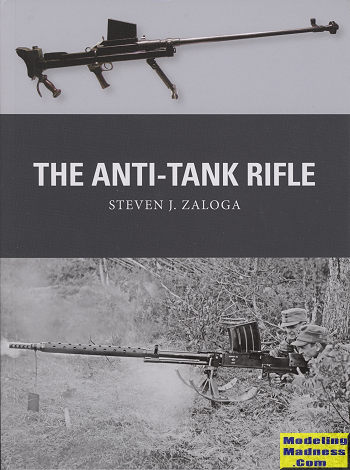 There are
times in the history of the weapons of warfare, where a weapon just doesn't
really turn out to be what was hoped for. The anti-tank rifle is one of those.
There are
times in the history of the weapons of warfare, where a weapon just doesn't
really turn out to be what was hoped for. The anti-tank rifle is one of those. |
Author: |
Steven Zaloga |
|
Publisher/Distributor |
Osprey Publishing |
|
Price |
$20.00 MSRP |
|
Reviewer: |
|
| Notes: |
80 pages, 7¼ x 9¼ inches, softbound ISBN: 978-1-4728-1722-8 |
 There are
times in the history of the weapons of warfare, where a weapon just doesn't
really turn out to be what was hoped for. The anti-tank rifle is one of those.
There are
times in the history of the weapons of warfare, where a weapon just doesn't
really turn out to be what was hoped for. The anti-tank rifle is one of those.
A true rifle is something that can be man-carried though in some cases it took more than one man. The armor of tanks when these rifles were developed was not very thick. Usually less than 20mm. The trick in making a good anti-tank rifle was making one that could penetrate that armor. This was done in a several ways.
One was to increase the amount of powder in a bullet. This would provide higher velocity. Also useful was a much longer barrel. In fact, just about all of these rifles had exceeding long barrels. Then one could produce a larger than average bullet/shell which, with more propellant, would achieve a higher velocity. There was also the trick of reducing the bore of the gun barrel which would 'squeeze' the shell and provide a much higher velocity, though in that case it would cause the barrel to wear rather quickly. All of these weapons had special hardened shells to help with penetration of the armor.
However, as WWII progressed, tank makers realized they needed more in terms of armor protection. As the armor thickness increased, the viability of the anti-tank rifle decreasesd. By mid-war, they were pretty much useless against even the light tanks then being produced. In the later part.
Of course, this did not mean that armies tossed them. These weapons were still quite useful against soft skin vehicles and against hardened positions. Indeed, the Soviets, who started WWII with no anti-tank rifles, built more than anyone else and used them with some success against German armor by aiming for the wheels and treads. This caused the Germans to develop the side skirts one sees in photos from Kursk to the end of the war.
In this book, the author covers the reasons for developing these weapons as well as what was developed by those nations who chose to use these rifles. Then we get into the use of the anti-tank rifle in combat and how its usage changed with time. Thanks to the great photos and easily understood commentary as well as the excellent illustrations provided, we get a very good history of these weapons and how history passed them by.
April 2018
Copyright ModelingMadness.com. All rights reserved.
For more on the complete line of Osprey books, visit www.ospreypublishing.com
If you would like your product reviewed fairly and quickly, please contact me or see other details in the Note to Contributors.